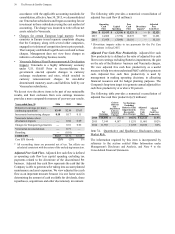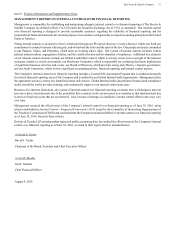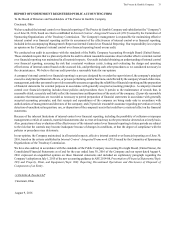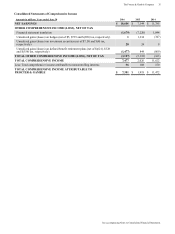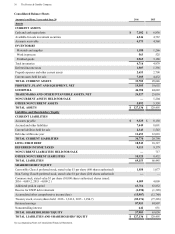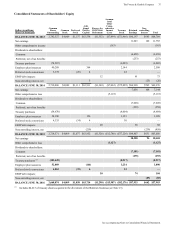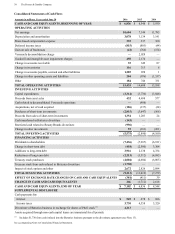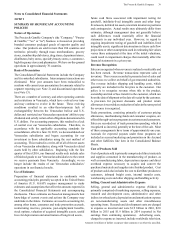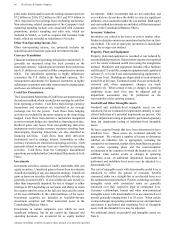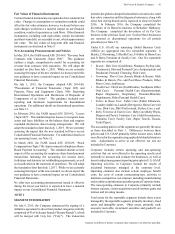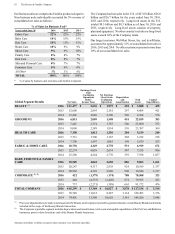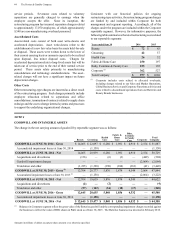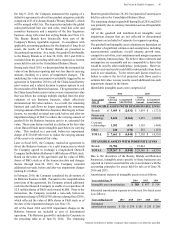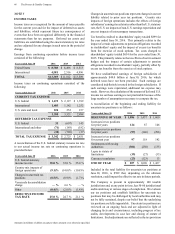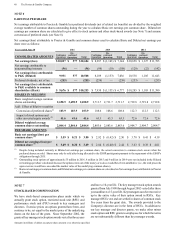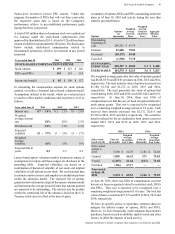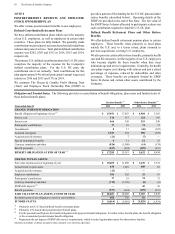Proctor and Gamble 2016 Annual Report Download - page 54
Download and view the complete annual report
Please find page 54 of the 2016 Proctor and Gamble annual report below. You can navigate through the pages in the report by either clicking on the pages listed below, or by using the keyword search tool below to find specific information within the annual report.40 The Procter & Gamble Company
Amounts in millions of dollars except per share amounts or as otherwise specified.
print, radio, internet and in-store advertising expenses and were
$7.2 billion in 2016, $7.2 billion in 2015 and $7.9 billion in
2014 (reported in Net earnings from continuing operations).
Non-advertising related components of the Company's total
marketing spending include costs associated with consumer
promotions, product sampling and sales aids, which are
included in SG&A, as well as coupons and customer trade
funds, which are recorded as reductions to Net sales.
Other Non-Operating Income, Net
Other non-operating income, net, primarily includes net
acquisition and divestiture gains and investment income.
Currency Translation
Financial statements of operating subsidiaries outside the U.S.
generally are measured using the local currency as the
functional currency. Adjustments to translate those statements
into U.S. dollars are recorded in Other comprehensive income
(OCI). For subsidiaries operating in highly inflationary
economies, the U.S. dollar is the functional currency. Re-
measurement adjustments for financial statements in highly
inflationary economies and other transactional exchange gains
and losses are reflected in earnings.
Cash Flow Presentation
The Consolidated Statements of Cash Flows are prepared using
the indirect method, which reconciles net earnings to cash flow
from operating activities. Cash flows from foreign currency
transactions and operations are translated at an average
exchange rate for the period. Cash flows from hedging
activities are included in the same category as the items being
hedged. Cash flows from derivative instruments designated
as net investment hedges are classified as financing activities.
Realized gains and losses from non-qualifying derivative
instruments used to hedge currency exposures resulting from
intercompany financing transactions are also classified as
financing activities. Cash flows from other derivative
instruments used to manage interest, commodity or other
currency exposures are classified as operating activities. Cash
payments related to income taxes are classified as operating
activities. Cash flows from the Company's discontinued
operations are included in the Consolidated Statements of Cash
Flows.
Investments
Investment securities consist of readily marketable debt and
equity securities. Unrealized gains or losses from investments
classified as trading, if any, are charged to earnings. Unrealized
gains or losses on securities classified as available-for-sale are
generally recorded in OCI. If an available-for-sale security is
other than temporarily impaired, the loss is charged to either
earnings or OCI depending on our intent and ability to retain
the security until we recover the full cost basis and the extent
of the loss attributable to the creditworthiness of the issuer.
Investment securities are included as Available-for-sale
investment securities and Other noncurrent assets in the
Consolidated Balance Sheets.
Investments in certain companies over which we exert
significant influence, but do not control the financial and
operating decisions, are accounted for as equity method
investments. Other investments that are not controlled, and
over which we do not have the ability to exercise significant
influence, are accounted for under the cost method. Both equity
and cost method investments are included as Other noncurrent
assets in the Consolidated Balance Sheets.
Inventory Valuation
Inventories are valued at the lower of cost or market value.
Product-related inventories are maintained on the first-in, first-
out method. The cost of spare part inventories is maintained
using the average-cost method.
Property, Plant and Equipment
Property, plant and equipment is recorded at cost reduced by
accumulated depreciation. Depreciation expense is recognized
over the assets' estimated useful lives using the straight-line
method. Machinery and equipment includes office furniture
and fixtures (15-year life), computer equipment and capitalized
software (3- to 5-year lives) and manufacturing equipment (3-
to 20-year lives). Buildings are depreciated over an estimated
useful life of 40 years. Estimated useful lives are periodically
reviewed and, when appropriate, changes are made
prospectively. When certain events or changes in operating
conditions occur, asset lives may be adjusted and an
impairment assessment may be performed on the
recoverability of the carrying amounts.
Goodwill and Other Intangible Assets
Goodwill and indefinite-lived intangible assets are not
amortized, but are evaluated for impairment annually or more
often if indicators of a potential impairment are present. Our
annual impairment testing of goodwill is performed separately
from our impairment testing of indefinite-lived intangible
assets.
We have acquired brands that have been determined to have
indefinite lives. Those assets are evaluated annually for
impairment. We evaluate a number of factors to determine
whether an indefinite life is appropriate, including the
competitive environment, market share, brand history, product
life cycles, operating plans and the macroeconomic
environment of the countries in which the brands are sold. In
addition, when certain events or changes in operating
conditions occur, an additional impairment assessment is
performed and indefinite-lived assets may be adjusted to a
determinable life.
The cost of intangible assets with determinable useful lives is
amortized to reflect the pattern of economic benefits
consumed, either on a straight-line or accelerated basis over
the estimated periods benefited. Patents, technology and other
intangible assets with contractual terms are generally
amortized over their respective legal or contractual lives.
Customer relationships, brands and other non-contractual
intangible assets with determinable lives are amortized over
periods generally ranging from 5 to 30 years. When certain
events or changes in operating conditions occur, an impairment
assessment is performed and remaining lives of intangible
assets with determinable lives may be adjusted.
For additional details on goodwill and intangible assets see
Note 4.


